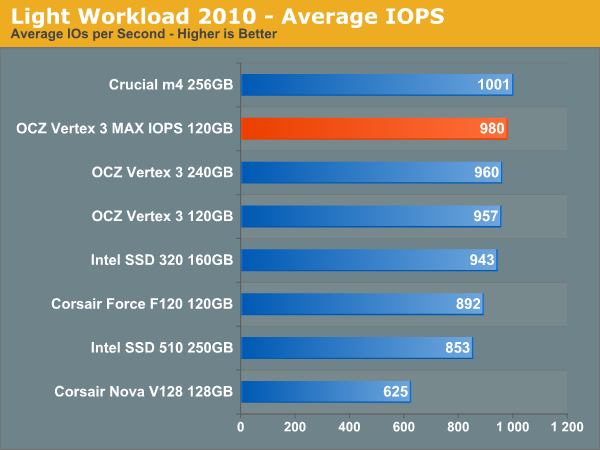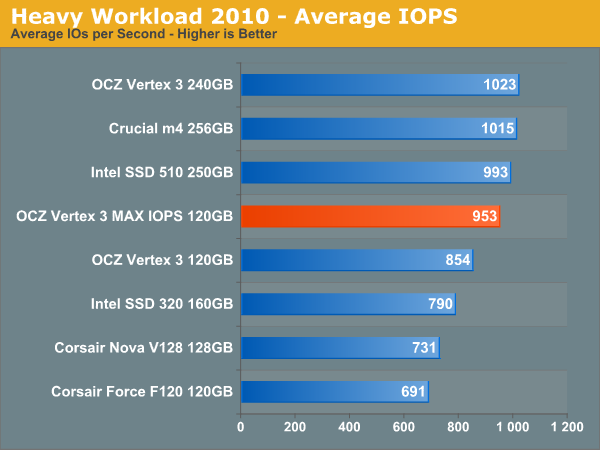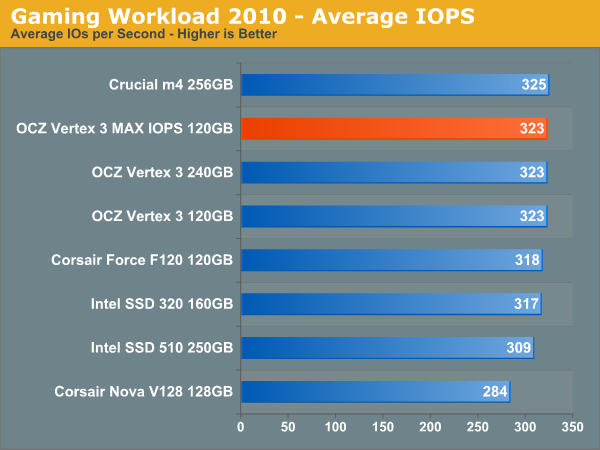OCZ Vertex 3 MAX IOPS & Patriot Wildfire SSDs Reviewed
by Anand Lal Shimpi on June 23, 2011 4:35 AM ESTAnandTech Storage Bench 2010
To keep things consistent we've also included our older Storage Bench. Note that the old storage test system doesn't have a SATA 6Gbps controller, so we only have one result for the 6Gbps drives.
The first in our benchmark suite is a light/typical usage case. The Windows 7 system is loaded with Firefox, Office 2007 and Adobe Reader among other applications. With Firefox we browse web pages like Facebook, AnandTech, Digg and other sites. Outlook is also running and we use it to check emails, create and send a message with a PDF attachment. Adobe Reader is used to view some PDFs. Excel 2007 is used to create a spreadsheet, graphs and save the document. The same goes for Word 2007. We open and step through a presentation in PowerPoint 2007 received as an email attachment before saving it to the desktop. Finally we watch a bit of a Firefly episode in Windows Media Player 11.
There’s some level of multitasking going on here but it’s not unreasonable by any means. Generally the application tasks proceed linearly, with the exception of things like web browsing which may happen in between one of the other tasks.
The recording is played back on all of our drives here today. Remember that we’re isolating disk performance, all we’re doing is playing back every single disk access that happened in that ~5 minute period of usage. The light workload is composed of 37,501 reads and 20,268 writes. Over 30% of the IOs are 4KB, 11% are 16KB, 22% are 32KB and approximately 13% are 64KB in size. Less than 30% of the operations are absolutely sequential in nature. Average queue depth is 6.09 IOs.
The performance results are reported in average I/O Operations per Second (IOPS):

If there’s a light usage case there’s bound to be a heavy one. In this test we have Microsoft Security Essentials running in the background with real time virus scanning enabled. We also perform a quick scan in the middle of the test. Firefox, Outlook, Excel, Word and Powerpoint are all used the same as they were in the light test. We add Photoshop CS4 to the mix, opening a bunch of 12MP images, editing them, then saving them as highly compressed JPGs for web publishing. Windows 7’s picture viewer is used to view a bunch of pictures on the hard drive. We use 7-zip to create and extract .7z archives. Downloading is also prominently featured in our heavy test; we download large files from the Internet during portions of the benchmark, as well as use uTorrent to grab a couple of torrents. Some of the applications in use are installed during the benchmark, Windows updates are also installed. Towards the end of the test we launch World of Warcraft, play for a few minutes, then delete the folder. This test also takes into account all of the disk accesses that happen while the OS is booting.
The benchmark is 22 minutes long and it consists of 128,895 read operations and 72,411 write operations. Roughly 44% of all IOs were sequential. Approximately 30% of all accesses were 4KB in size, 12% were 16KB in size, 14% were 32KB and 20% were 64KB. Average queue depth was 3.59.

The gaming workload is made up of 75,206 read operations and only 4,592 write operations. Only 20% of the accesses are 4KB in size, nearly 40% are 64KB and 20% are 32KB. A whopping 69% of the IOs are sequential, meaning this is predominantly a sequential read benchmark. The average queue depth is 7.76 IOs.











112 Comments
View All Comments
poohbear - Thursday, June 23, 2011 - link
Thank you for being upfront at the very beginning about "the elephant in the room"! some sites were blamed for ignoring the issue, but u guys were spot on about it and to be honest its one of the main reason i've been steering clear of any Sandforce 2000 based SSDs. two thirds of a percent? why give it in such a complicated way???? two thirds of a percent is .6% of all drives? why not just say 1% of all drives, but yea i understand disgruntled consumers are often the most vocal about a problem.Nice review though, might look into this when they have some new and more mature firmwares. Right now im fine with my Crucial C300 64gb.^^
bivoy - Thursday, June 23, 2011 - link
strange, my A DATA SSD 599 (sandforce 1XXX based) has died two weeks ago when I left notebook in sleep mode overnight .......iron11 - Thursday, June 23, 2011 - link
After reading many reviews of OCZ, I went ahead and bought 2 of them. Let me tell you.. 2 months of owning these SSD's... BSOD's over and over and over and over again. Look at OCZ forums and tell me that its a 1% failure rate. I really hope anyone who's thinking of buying these SSD's look into Intel 510/320's. They're reliability/speed is there. I will never buy OCZ again.. i'll pay the extra surcharge fee Intel charges. I'll pay it not for the name.. but the track record behind Intel's SSD.OCZ = Bad
seapeople - Thursday, June 23, 2011 - link
As explained in this article, the OCZ BSOD issue is not a reliability issue whereby drives degrade in quality and "break", but rather a compatibility issue with certain system configurations. If your system is incompatible with the Sandforce-based drive for an as-yet undetermined reason, then EVERY similar Sandforce-based drive will give you BSOD's. This explains why there are such conflicting reviews of these drives: reviewers like Anand can put dozens of these drives into a few different systems, and because none of these systems have a compatibility issue the drives work perfectly. Meanwhile the people who do have a system-compatibility issue can RMA a dozen of these drives and every single one of them will fail.It sounds like if you take on of these BSOD drives out of a user's system and put it in a different system it will work perfectly, which is part of why OCZ is having such trouble diagnosing the issue.
All that said, I'm glad I bought an Intel.
spidey81 - Thursday, June 23, 2011 - link
I was curious to see current pricing and availability after reading this article and found a little surprise. When Anand spoke about the price premium not being worth the jump up to the MAX IOPS from the base V3 I wanted to look myself and see what they were going for or if there were any deals. What I came across was a Corsair Force 3 for $180 after rebate ( $210 without ). This is the drive mentioned in the first page of that article that Corsair recently recalled. But the problem has been addressed and this seems like a hell of a deal!Beenthere - Thursday, June 23, 2011 - link
As we see with many PC products these days, many are shipped well before they are ready for primetime. Sure those who only use their PC for games might be willing to buy unreliable, half-baked products but no one with a clue would touch these unreliable products. As long as the sheep line up to pay a premium for the half-baked product of the week, manufacturers will continue to ship half-baked crap and there are numerous popular brands who routinely do this as noted by the product defect reports.Axonn - Thursday, June 23, 2011 - link
I think Anand forgot to mention another reason why the V3 MI is worth it: 32nm NAND means it has more life cycles in it.Impulses - Thursday, June 23, 2011 - link
Honestly, how many times have we as enthusiasts encountered a particular motherboard (even on a business class laptop) that didn't play will with a certain brand of RAM or vice versa, or a GPU that was unstable on certain platforms, etc etc. When you're a DIY enthusiast this comes with the territory... There's always gonna be some products/brands that are more reliable, if you value your time a lot then opt for those.I don't see anything wrong with AT's coverage as is, he has ALWAYS mentioned that Sandforce drives pose a reliability risk (vs Intel) in the same breath that he talks about their performance... If you visit message boards this has always been quite obvious. If anything I'd just hope for a quicker mention of some of the emerging issues.
I understand Anand can't document something he hasn't experienced and I imagine getting info from OCZ is hard when they haven't been able to pin down the problem, but still, an earlier warning that there might be a very real issue would be good (regardless of how uncommon).
npp - Thursday, June 23, 2011 - link
The current prices of the third generation Vertex drives here in Germany:OCZ Vertex 3 240GB: 198,51€ (MAXIOPS Version: 247,50€)
OCZ Vertex 3 240GB: 422,68€ (MAXIOPS Version: 485,98€)
If you want the prices in USD, do the math for yourself, but one thing is clear, those don't come cheap.
Personally, I wouldn't bother spending so much money on a drive with *known* issues. It's plain unreasonable. A 300GB Intel 320 drive costs 429€ around here, so you get the point. Sure, it's a "last gen" drive and slower on paper per se, but I'm sure even Anand will be hard pressed to tell the difference from a Vertex 3 in real life.
OCZ played it really when with the second-gen Vertex, but I think they got a bit of an overshoot this time. Given how fast SSD are to begin with, I would be perfectly fine with more incremental changes between generations, if that means better reliability. Going for the big figures and then getting BSODs isn't the right way to do things, I think. Issues such as those still hold me back from getting a SSD in my notebook. I typically use a system for about 3 years before upgrading, and I want a drive that will cut it through all that time without a glitch. Given that even Intel messes things up occasionally, I wonder when such a drive will make it to market.
Makaveli - Thursday, June 23, 2011 - link
"There's a percentage of OCZ Vertex 3/Agility 3 customers that have a recurring stuttering/instability issue."This is unacceptable on a storage device that will host an operating system, I don't care if this thing pushes 1 million ops and takes out the garbage.
And still the reason I only look at intel drives for ssd.
Stability > speed when it comes to storage devices.